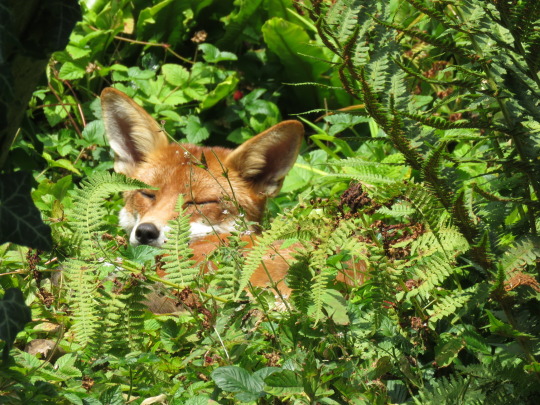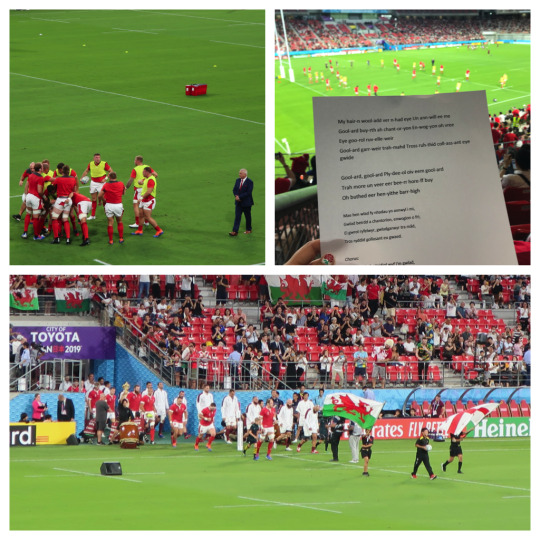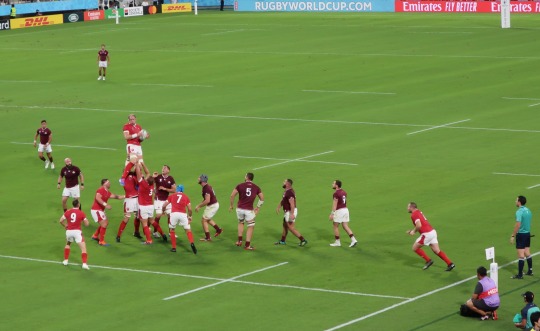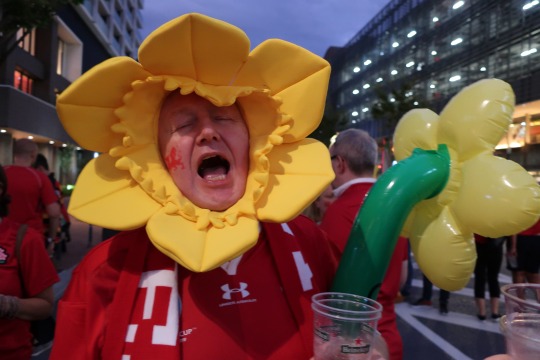#got to see red foxes in England & Ireland & Scotland
Text

Oh, to be a sleepy red fox in the sunshine ☀️
#got to see red foxes in England & Ireland & Scotland#I know they’re far more common here than in the states but I still felt very blessed!#one of my favorite creatures 🥰
1K notes
·
View notes
Text
The Rugby World Cup
The first weekend, The first game
September 20th 2019

So after much anticipation and preparation it had finally arrived. The Rugby World Cup in Japan. We kicked it off with other rugby fans in a bbq joint with unreliable wifi connection. We cheered on the hosts against Russia. After an average match it was good to watch Matt Damon doing his best South African accent in Invictus.
We then had to pace ourselves through the first rainy weekend of rugby. We watched The French make a promising start against Argentina in an appropriately smokey little bar. We then headed across town to our favourite Rugby bar the Coat of Arms to watch the first crunch match of South Africa vs New Zealand.

By the Sunday our brains were a bit rugby scrambled or pickled by the alcohol but it was time to watch the home nations perform so we powered through.
We were excited to see Scotland take on Ireland and for England’s debut against Tonga. As we headed across Nagoya to meet up with rugby loving friends we started to notice a few Welsh shirts making an appearance. This was because Wales’ first match was due to take place on the Monday in nearby Toyota. We even offered assistance to some lost looking Welsh fans and invited them to join us at our local haunt. As we arrived it appeared that The Coat of Arms had been taken over by a sea of red shirted tourists. There was the odd pop of white in this blanket of red, it was just nice to hear British accents mingling all around us.
We watched on as Scotland fell at the first hurdle and Ireland looked like they deserved their recently earned no1 World ranking. Then it was England’s go. Not the most convincing start. The home nations battle lines began to show up as the mass of Welsh supporters wholeheartedly supported Tonga.

It was a great atmosphere and by the end of the evening the Welsh had unsurprisingly burst into song.

The game
September 23rd 2019
This was our first game of the World Cup. We were so excited to have our first taste of the tournament and it was relatively close to home in Toyota. As it was our local game it meant lots of our friends were in attendance which added to the party feel. The Welsh supporters came in their droves. Our first encounter was with a couple of Japanese who had adopted Wales as their country to support. Now something you need to know. Japanese people love to dress up. Rugby supporters - love to dress up. This was one aspect of the World Cup that I knew would prove to be a hit with the Japanese. We knew that the Japanese couple were supporting Wales as the girl was wearing a Welsh shirt (standard), and Welsh Flag tied around her neck (OK) she also had a Welsh bag, and sheep hat! The guy was similarly kitted out except he had a dragon hat. Good work guys!

Of course I was taking a photo of Rob on the train - Not the Japanese/Welsh supporters behind him!
We arrived nice and early for the match to check out the fanzone and the festival atmosphere.

As we completed a loop of the festivities we got our first close up look at the Webb Ellis trophy.

We checked out the fanzone, collected free stuff and drank the sponsored beverages. After walking what felt like a significant distance we made it back around to meet up with our friends at the British Theme pub - Boobies. Not sure if the Japanese understand the name!

Facepaint was applied to the native supporters (our mate Russ) and we were ready.

We had seen the Georgian team play against Japan in this very stadium a little over a year before. At that time Japan’s dynamism kept the unit-like Georgians to a clean sheet. This Georgian team’s backs looked a completely different physical shape, smaller more agile and ready to put up a fight against the Welsh.
We were sitting in the East stand and luckily for us the Welsh team were playing to our end first.

We excitedly watched the warm up spotting the familiar faces of the Welsh heroes.
We gave the Welsh National anthem a good go, thanks to Mel for providing a phonetic version, and then we were ready to cheer the boyos on.
Sitting with our Welsh flower (our mate Russ), we had an excellent view, as Jonathan ‘Fox’ Davies provided the first try for Wales after just 3 minutes. This was followed up by Justin Tipuric and Josh Adams within the first 20. Dan Biggar slotted over the conversions surely buoyed buy the reassuring chanting from the crowd (Mel) of Dan, Dan he’s our man if he can’t do it no one can!

Maybe due to it being one of the first matches of the world cup or due to nerves there a was a large amount of TMO usage. This really slowed the momentum of the game down and quietened the crowd. Having experienced the choral excellence of the Welsh fans just the night before in the COA we were surprised at the general lack of singing during the match. The Welsh fans were separated into smaller groups throughout the stadium so this may have been a factor.

The Welsh score was building well with Liam Williams securing the 4 try bonus point before half time. This seemed to lead to some complacency meaning that the Georgians were able to squeeze in a try and conversion early on in the second half.
As the Georgians seemed to tire, Tomos Williams added a 5th try in the 65th minute. The Georgians managed to capitalise on a tap and go penalty to penetrate the Welsh defence at 69 minutes. Then Tomos Williams again showed his skill with some ducking and fancy footwork to offload to George North who finished the final try of the game in the 75th minute.
The final score 43-14 to Wales.
As we walked back towards “Boobies” across the connecting bridge we were entertained with the full Welsh repertoire. Delilah, bread of Heaven, National anthem, on repeat.

We finished our evening drinking and singing with the rest of the red army. A great first outing of the world Cup.

0 notes
Text
A checklist for British mammals
Tier 1, widespread, common and readily sightable mammals.
Oryctolagus cuniculus (rabbit), seen.
Sciurus carolinensis (grey squirrel), seen. Absent from the Scottish Highlands, and from some other areas of the British Isles such as the Lake District where it is kept out by human effort in order to preserve the red squirrel population.
Tier 2, widespread and common but not readily sightable mammals.
Lepus europaeus (brown hare), not definitely seen (sometimes I've seen things that I'm not sure whether they are rabbits or hares). Absent from Ireland.
Myodes glareolus (bank vole), never seen. Used to be absent from Ireland, but has recently been introduced there.
Mus musculus (house mouse), seen (one of them got into the kitchen of my parents' house one time).
Apodemus sylvaticus (wood mouse), never seen (in Britain at any rate; I saw a mouse in Spain once which was probably of this species).
Rattus norvegicus (brown rat), seen (much more often dead than alive, but I have seen a live one once).
Talpa europaea (mole), never seen (though I've seen their molehills). Absent from Ireland.
Sorex araneus (common shrew), maybe seen dead, but certainly never alive (the neighbour's cat deposited a shrew on my parent's doorstep once, which could have been a common shrew or a pygmy shrew). Absent from Ireland.
Sorex pygmaeus (pygmy shrew), maybe seen dead, but certainly never alive (see above).
Chiroptera (bats), seen (only flitting past in the dark). The various bat species are hard to tell apart under ordinary circumstances (where you can never get a proper look at them).
Capreolus capreolus (roe deer), never seen. Absent from Ireland.
Dama dama (fallow deer), never seen.
Cervus elaphus (red deer), never seen.
Vulpes vulpes (fox), seen (once, very briefly—I'd like to get a closer look sometime).
Meles meles (badger), seen remotely via a recording, but not directly (in the Lake District).
Mustela neovision (American mink), never seen.
Mustela erminea (stoat), never seen.
Mustela nivalis (weasel), never seen.
Tier 3, mammals with widespread distributions but which are only locally common.
Arvicola amphibius (water vole), never seen. Absent from Ireland.
Microtus agrestis (field vole), never seen. Absent from Ireland.
Micromys minutus (harvest mouse), never seen. Absent from Scotland and Ireland.
Erinaceus europaeus (hedgehog), seen (one time in the Lake District, and several times in York—for some reason in September 2014 they were all over the place, even just on the streets in the middle of the city around evening time, though I've never seen any again since that time).
Neomys fodiens (water shrew), never seen. Absent from Ireland.
Lutra lutra (otter), never seen (except in captivity).
Mustela putorius (polecat), never seen. They're absent from Ireland, most of Scotland and northern England, and generally uncommon.
Phoca vitulina (common seal), maybe seen (I've seen a few seals, e.g. in Cornwall, but I wouldn't be able to tell a common seal from a grey seal).
Halichoerus grypus (grey seal), seen (I'm pretty sure I've seen grey seals while on a boat somewhere where the captain explicitly pointed them out to us and said that they were grey seals).
Tier 4, mammals with somewhat restricted distributions, but which are common where they are found.
Lepus timidus (mountain hare), never seen. They're found in the Peak District and the Scottish Highlands.
Lepus timidus hibernicus (Irish hare), never seen. They're found in Ireland.
Sciurus vulgaris (red squirrel), seen (in the Lake District). Their main reservoir is in the Scottish Highlands; wherever the grey squirrel spreads, they are outcompeted.
Apodemus flavicollis (yellow-necked mouse), never seen. Found in southern England, the West Midlands and parts of eastern Wales.
Muntiacus reevesi (Reeves' muntjac), never seen. They're restricted to southern England and the Midlands.
Tier 5, mammals with very highly restricted distributions, but which are common where they are found.
Glis glis (edible dormouse), never seen. They're found in to a small area near the Chiltern Hills, to which they were introduced about a century ago.
Myodes glareolus skomerensis (Skomer vole), never seen. They're only found on Skomer, off the west coast of Wales.
Apodemus sylvaticus hirtensis (St Kilda field mouse), never seen. They're only found on St Kilda, off the west coast of Scotland.
Microtus arvalis orcadensis (Orkney vole), never seen. They're only found in Orkney. They are a subspecies of the common vole, which despite being common in continental Europe is absent from the island of Great Britain.
Microtus arvalis sarnius (Guernsey vole), never seen. They're only found on Guernsey, and are another subspecies of the common vole.
Crocidura suaveolens (lesser white-toothed shrew), never seen. They're found on the Isles of Scilly and the Channel Islands).
Sorex coronatus (crowned shrew), never seen. They're found on Jersey.
Hydropotes inermis (Chinese water deer), never seen. They're restricted to a part of the northeastern Home Counties extending into nearby East Anglia and East Midlands. They were only introduced during the 20th century, and though now well-established remain somewhat uncommon.
Cervus nippon (sika deer), never seen. They're restricted to a few areas where they were introduced during the 20th century, such as Dorset. Although they have not become widespread like e.g. Reeves' muntjac, they are common where they are found.
Tier 6, rare mammals with restricted distributions.
Muscardinus avellanarius (common dormouse), never seen. They're only found in Wales, the West Midlands and southern England, and nowhere common.
Crocidura russula (greater white-toothed shrew), never seen. They have very recently been accidentally introduced to Ireland.
Felis silvestris (wildcat), never seen. They're only found in the Scottish Highlands, but very rare even there.
Martes martes (pine marten), never seen. They're mostly found in the Scottish Highlands, and very rare elsewhere.
Tier 7, rare mammals with highly restricted distributions.
Macropus rufogriseus (red-necked wallaby), never seen (except in captivity). There are a few small escaped populations, including one on the Isle of Man and another on the island of Inchconnachan in Loch Lomond.
Castor fiber (beaver), never seen. They're only found in scattered locations where they've been reintroduced very recently, during the 21st century, so their numbers are still small.
Rattus rattus (black rat), never seen (although I doubt I could tell these from brown rats reliably; but brown rats are vastly more common, black rats only being found in port areas where they are occasionally introduced on ships, and on some isolated islands).
Sus scrofa (wild boar), never seen. They're only found in scattered locations in southern England where they've recently been reintroduced.
1 note
·
View note